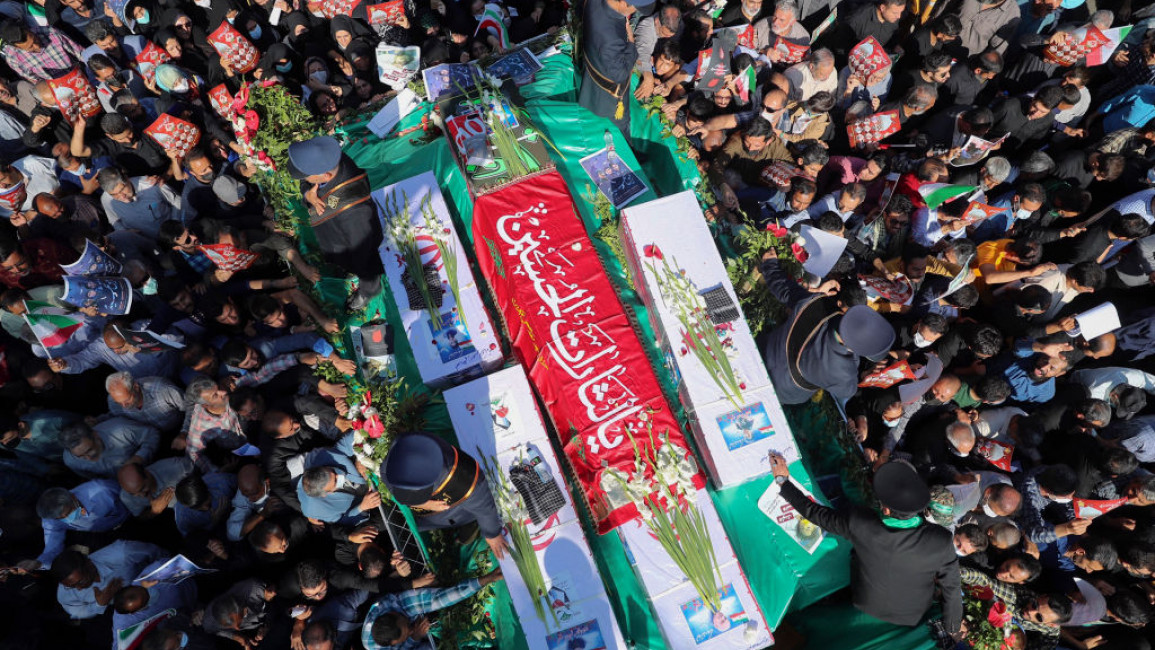Explainer: Who benefits from the attack on Shiraz?
A freshly crafted slogan was chanted during Saturday's anti-government protest on the Tehran University campus. "Shah Cheragh is another Rex, this is just one more pretext," students in Tehran shouted.
The attack on the most important religious shrine in the Iranian city of Shiraz was carried out on October 26, and the Islamic State group (IS) claimed responsibility for the attack.
However, the students' slogan clearly showed that many of the protesters do not believe the regime's narrative over the attack. Several ordinary Iranians The New Arab spoke with share the same sentiment.
The 'Rex' that students referred to was a cinema in the southwestern city of Abadan, which was set on fire during the anti-Shah protests in 1978. The Shah's dictatorial regime blamed the Islamists for the death of about 400 people in the fire, but ordinary Iranian did not buy that narrative and put the blame on the Shah.
Forty-four years after Cinema Rex Fire, now the Islamic Republic of Iran blames the jihadist IS group for killing 15 citizens in the Shah Cheragh shrine. Still, many Iranians do not believe it, despite IS's claim over the attack.
'Who benefits from the attack?'
"Just look how timely the attack was," a student activist who introduced himself as Arash said to TNA. "The attack was like a gift from heaven falling on the establishment's lap, giving them the best excuse to kill more protestors."
Since mid-September, several Iranian cities witnessed anti-government protests, in which at least 253 were killed, according to human rights organizations outside the country. Demonstrations began after the death of the 22-year-old Mahsa Amini in Iran's "Islamic morality police" for allegedly not "wearing a hijab appropriately".
In response to the government's statements about the Shiraz attack, Arash, who had participated in several protests in Tehran, raised one question: "who benefits from the attack?"
"Daesh? No, because they don't even have a branch in Iran," he answered his own question, using an Arabic acronym for IS. "The protestors? No, because they would face a harsher crackdown. This is only the regime that profits from the attack."
Reactions by Iranian officials and the Islamic Revolutionary Guard Corps (IRGC) commanders have fueled people's doubt about those who carried out the attack.
"Disorder and riots provide the context for terrorist attacks," Hamshahri Online quoted President Ebrahim Raisi as saying. Iranian authority labels the anti-government protests as riots.
A few hours after the attack, an IRGC top commander, major general Mohammad Bagheri, warned the anti-government protestors of severe punishments, relating them to the attack in Shiraz.
"The rioters and deceived ones, who are definitely complicit in this major crime, should know that the red line for Iran's military is people's security and peace," he wrote in a short statement.
History of false flag operations
Independent Analysts in Iran underline that the same strategy was deployed by the IRGC and the country's notorious intelligence ministry to crush dissidents and protests.
Speaking to TNA on condition of anonymity, an Iranian analyst said the establishment would soon gear up for a more fierce crackdown.
"Considering international pressures on Iran's drone program and a halt in the nuclear talks, the system cannot afford a nationwide anti-establishment movement," he explained. "Now, they need the highest brutality level to contain the demonstration fully."
"The same scenario was played during the 2009 Green Movement when the deadly Ashoura demonstrations happened in Iran," he added, referring to incidents that led to the house arrest of two leaders of the Green Movement.
In June 2009, large-scale rallies began in Tehran in protest to the reelection of former president Mahmoud Ahmadinejad. The clashes between anti-riot police and protestors continued until the Ashoura ritual occurred in December.
Ashoura is the day Shia believers mourn the death of Hussein ibn Ali, the third Shia Imam. On that year's Ashoura, some mourning tents in central Tehran, with verses from the Qoran written on the walls, were set on fire.
The establishment blamed the protestors for the "blasphemous act" and crushed the demonstrations heavy-handedly.
Another example that the political analyst referred to was the 1994 explosion in the holly shrine of Imam Reza in Iran's second-largest city, Mashhad. That attack claimed 25 lives, and the authorities accused the Mojahedin-e Khalq (MEK), an armed Iranian opposition group, of the attack.
Despite the MEK rejecting the accusation and a Pakistani jihadist group claiming responsibility for the attack, Iran used the explosion as a pretext for further pressure on Iranian dissidents.
The authorities' long history of misinformation and false accusation has made it difficult for many Iranians to believe that the IS group was behind last week's attack in Shiraz.
"We don't know if that was a false flag attack in Shiraz or if the IS group was genuinely behind it. History will eventually reveal that," the analyst said.
"But we know for sure that, after the attack, the establishment will more brutally crush the protests, and more lives will be lost."

![At least 87 were killed in an Israeli air strike on Beit Lahia in north Gaza [Getty]](/sites/default/files/styles/image_684x385/public/2178754081.jpeg?h=a5f2f23a&itok=rWbrlpHd)
![Trump promised that Lebanese people will be "happy" in the end, in comments made in a rally in Michigan [Getty]](/sites/default/files/styles/image_684x385/public/2112640005.jpeg?h=a5f2f23a&itok=P91hgdKY)


 Follow the Middle East's top stories in English at The New Arab on Google News
Follow the Middle East's top stories in English at The New Arab on Google News
![Blinken heads to Israel [Getty]](/sites/default/files/styles/image_330x185/public/2179125652.jpeg?h=a5f2f23a&itok=qddhTzNd)
![Ambulance near the struck Rafik Hariri government hospital [Getty]](/sites/default/files/styles/image_330x185/public/2179173250.jpeg?h=a5f2f23a&itok=aZ7tkRsO)
![Protest commemorating Sinwar and Haniyeh [Getty]](/sites/default/files/styles/image_330x185/public/2179413541.jpeg?h=a5f2f23a&itok=SSYDHhev)